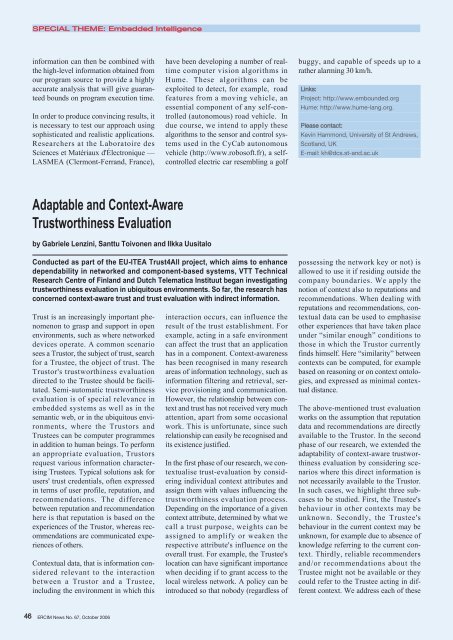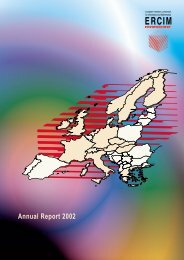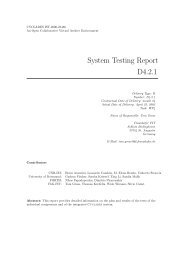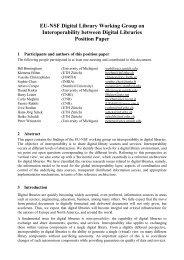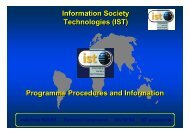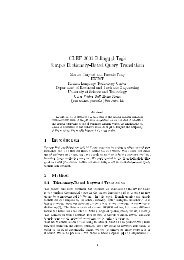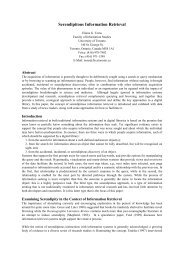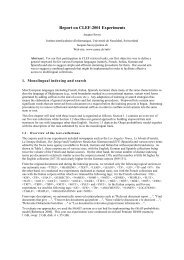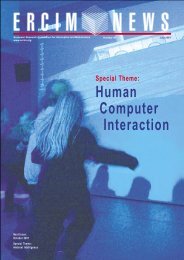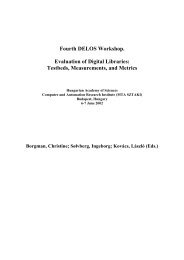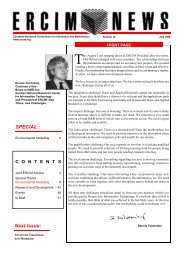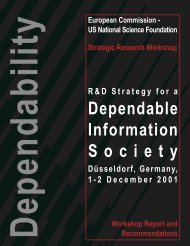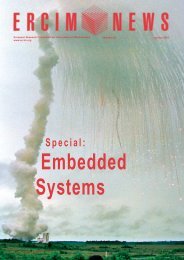Towards a Platform for Widespread Embedded Intelligence - ERCIM
Towards a Platform for Widespread Embedded Intelligence - ERCIM
Towards a Platform for Widespread Embedded Intelligence - ERCIM
You also want an ePaper? Increase the reach of your titles
YUMPU automatically turns print PDFs into web optimized ePapers that Google loves.
SPECIAL THEME: <strong>Embedded</strong> <strong>Intelligence</strong><br />
in<strong>for</strong>mation can then be combined with<br />
the high-level in<strong>for</strong>mation obtained from<br />
our program source to provide a highly<br />
accurate analysis that will give guaranteed<br />
bounds on program execution time.<br />
In order to produce convincing results, it<br />
is necessary to test our approach using<br />
sophisticated and realistic applications.<br />
Researchers at the Laboratoire des<br />
Sciences et Matériaux d'Électronique —<br />
LASMEA (Clermont-Ferrand, France),<br />
Adaptable and Context-Aware<br />
Trustworthiness Evaluation<br />
by Gabriele Lenzini, Santtu Toivonen and Ilkka Uusitalo<br />
have been developing a number of realtime<br />
computer vision algorithms in<br />
Hume. These algorithms can be<br />
exploited to detect, <strong>for</strong> example, road<br />
features from a moving vehicle, an<br />
essential component of any self-controlled<br />
(autonomous) road vehicle. In<br />
due course, we intend to apply these<br />
algorithms to the sensor and control systems<br />
used in the CyCab autonomous<br />
vehicle (http://www.robosoft.fr), a selfcontrolled<br />
electric car resembling a golf<br />
Conducted as part of the EU-ITEA Trust4All project, which aims to enhance<br />
dependability in networked and component-based systems, VTT Technical<br />
Research Centre of Finland and Dutch Telematica Instituut began investigating<br />
trustworthiness evaluation in ubiquitous environments. So far, the research has<br />
concerned context-aware trust and trust evaluation with indirect in<strong>for</strong>mation.<br />
Trust is an increasingly important phenomenon<br />
to grasp and support in open<br />
environments, such as where networked<br />
devices operate. A common scenario<br />
sees a Trustor, the subject of trust, search<br />
<strong>for</strong> a Trustee, the object of trust. The<br />
Trustor's trustworthiness evaluation<br />
directed to the Trustee should be facilitated.<br />
Semi-automatic trustworthiness<br />
evaluation is of special relevance in<br />
embedded systems as well as in the<br />
semantic web, or in the ubiquitous environments,<br />
where the Trustors and<br />
Trustees can be computer programmes<br />
in addition to human beings. To per<strong>for</strong>m<br />
an appropriate evaluation, Trustors<br />
request various in<strong>for</strong>mation characterising<br />
Trustees. Typical solutions ask <strong>for</strong><br />
users' trust credentials, often expressed<br />
in terms of user profile, reputation, and<br />
recommendations. The difference<br />
between reputation and recommendation<br />
here is that reputation is based on the<br />
experiences of the Trustor, whereas recommendations<br />
are communicated experiences<br />
of others.<br />
Contextual data, that is in<strong>for</strong>mation considered<br />
relevant to the interaction<br />
between a Trustor and a Trustee,<br />
including the environment in which this<br />
46 <strong>ERCIM</strong> News No. 67, October 2006<br />
interaction occurs, can influence the<br />
result of the trust establishment. For<br />
example, acting in a safe environment<br />
can affect the trust that an application<br />
has in a component. Context-awareness<br />
has been recognised in many research<br />
areas of in<strong>for</strong>mation technology, such as<br />
in<strong>for</strong>mation filtering and retrieval, service<br />
provisioning and communication.<br />
However, the relationship between context<br />
and trust has not received very much<br />
attention, apart from some occasional<br />
work. This is un<strong>for</strong>tunate, since such<br />
relationship can easily be recognised and<br />
its existence justified.<br />
In the first phase of our research, we contextualise<br />
trust-evaluation by considering<br />
individual context attributes and<br />
assign them with values influencing the<br />
trustworthiness evaluation process.<br />
Depending on the importance of a given<br />
context attribute, determined by what we<br />
call a trust purpose, weights can be<br />
assigned to amplify or weaken the<br />
respective attribute's influence on the<br />
overall trust. For example, the Trustee's<br />
location can have significant importance<br />
when deciding if to grant access to the<br />
local wireless network. A policy can be<br />
introduced so that nobody (regardless of<br />
buggy, and capable of speeds up to a<br />
rather alarming 30 km/h.<br />
Links:<br />
Project: http://www.embounded.org<br />
Hume: http://www.hume-lang.org.<br />
Please contact:<br />
Kevin Hammond, University of St Andrews,<br />
Scotland, UK<br />
E-mail: kh@dcs.st-and.ac.uk<br />
possessing the network key or not) is<br />
allowed to use it if residing outside the<br />
company boundaries. We apply the<br />
notion of context also to reputations and<br />
recommendations. When dealing with<br />
reputations and recommendations, contextual<br />
data can be used to emphasise<br />
other experiences that have taken place<br />
under “similar enough” conditions to<br />
those in which the Trustor currently<br />
finds himself. Here “similarity” between<br />
contexts can be computed, <strong>for</strong> example<br />
based on reasoning or on context ontologies,<br />
and expressed as minimal contextual<br />
distance.<br />
The above-mentioned trust evaluation<br />
works on the assumption that reputation<br />
data and recommendations are directly<br />
available to the Trustor. In the second<br />
phase of our research, we extended the<br />
adaptability of context-aware trustworthiness<br />
evaluation by considering scenarios<br />
where this direct in<strong>for</strong>mation is<br />
not necessarily available to the Trustor.<br />
In such cases, we highlight three subcases<br />
to be studied. First, the Trustee's<br />
behaviour in other contexts may be<br />
unknown. Secondly, the Trustee's<br />
behaviour in the current context may be<br />
unknown, <strong>for</strong> example due to absence of<br />
knowledge referring to the current context.<br />
Thirdly, reliable recommenders<br />
and/or recommendations about the<br />
Trustee might not be available or they<br />
could refer to the Trustee acting in different<br />
context. We address each of these


